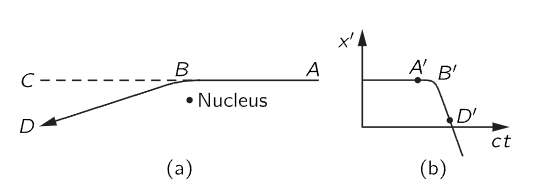
Bremsstrahlung
 المؤلف:
Richard Feynman, Robert Leighton and Matthew Sands
المؤلف:
Richard Feynman, Robert Leighton and Matthew Sands
 المصدر:
The Feynman Lectures on Physics
المصدر:
The Feynman Lectures on Physics
 الجزء والصفحة:
Volume I, Chapter 34
الجزء والصفحة:
Volume I, Chapter 34
 2024-03-26
2024-03-26
 1689
1689

Fig. 34–9. A fast electron passing near a nucleus radiates energy in the direction of its motion.
Suppose that there are charged particles in a piece of matter and a very fast electron, say, comes by (Fig. 34–9). Then, because of the electric field around the atomic nucleus the electron is pulled, accelerated, so that the curve of its motion has a slight kink or bend in it. If the electron is travelling at very nearly the speed of light, what is the electric field produced in the direction C? Remember our rule: we take the actual motion, translate it backwards at speed c, and that gives us a curve whose curvature measures the electric field. It was coming toward us at the speed v, so we get a backward motion, with the whole picture compressed into a smaller distance in proportion as c−v is smaller than c. So, if 1−v/c≪1, there is a very sharp and rapid curvature at B′, and when we take the second derivative of that we get a very high field in the direction of the motion. So when very energetic electrons move through matter they spit radiation in a forward direction. This is called bremsstrahlung. As a matter of fact, the synchrotron is used, not so much to make high-energy electrons (actually if we could get them out of the machine more conveniently, we would not say this) as to make very energetic photons—gamma rays—by passing the energetic electrons through a solid tungsten “target,” and letting them radiate photons from this bremsstrahlung effect.
 الاكثر قراءة في الفيزياء الذرية
الاكثر قراءة في الفيزياء الذرية
 اخر الاخبار
اخر الاخبار
اخبار العتبة العباسية المقدسة


